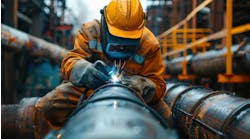Latest from Management
Have We Reached Critical Mass in the Trades?
Sponsored
As I pointed out in my last article, there are many different ways to deliver radiant comfort without having to utilize only the floors. In the four previous articles, we covered my personal application of a radiant wall system. In this, the last segment on radiant walls, I’d like to talk about the other methods I have seen employed in radiant wall applications.
My good friend Bob “Hot Rod” Rohr did a radiant wall project that was similar to the equivalent of a suspended floor heating system, whereby the tubing was run parallel to the studs and crossed the studs only near the bottom with two passes of tubing per stud cavity. The tubes were held in place using spanner bars, and the tubing was connected to that with a readily available product commonly used to support PEX tubing in plumbing applications. He placed fiberglass insulation on the back side of the bay to direct the transfer of energy toward the area he was attempting to condition and control. Applications like these, be they floors, walls or ceilings, are missing out on the benefits of the king of heat transfer —conductivity. In other words, while it will work, it requires a higher water temperature because it relies on less efficient methods of heat transfer — convective and radiant transfer. It works quite well with higher water temperatures (120°F to 170°F), but it is not conducive to the use of alternative energy — like solar or ground and air-source heat pumps — whose temperature usually limits out around 120°F to 130°F.
Radiant wall outputs are not limited to the 35 BTU per square foot per hour that radiant floors are, because with the walls, there is no human contact. Essentially, the only real operating temperature limitation of a wall is dictated by the finish materials used — like paint and wallpaper — or the paper of the sheetrock to which it is being applied.
A good rule of thumb is to keep the heat-emitting surface below 120°F. The output of a radiant wall has been determined to be 1.6 BTU per square foot per hour per degree Fahrenheit difference in room air temperature versus panel surface temperature. This means that with a surface temperature of 120°F, and a room temperature of 70°F, a radiant wall can be expected to produce 80 BTU per square foot per hour.
This is compared to a radiant floor, which has been determined to have an output of 2 BTU per square foot per hour per degree Fahrenheit difference in room air temperature versus panel surface temperature. Although it appears that the floor can emit more energy than a radiant wall assembly, the floor has an 85° F surface temperature limitation due to human contact, therefore capping its output at 35 BTU per square foot per hour. This shows that walls can put out more than twice as many BTU per square foot as a radiant floor and still deliver excellent comfort. In reality, the floors will not be as cold as they would have been with a conventional baseboard or other convective system. Another distinct benefit of using radiant walls is that we don’t have to worry about highly resistant materials being placed on the heat-emitting surface — like pad and carpet — which will result in lower water temperatures required to provide excellent comfort.
As can be seen through simple math, the walls would require half of the surface area that a floor would, while still delivering excellent overall radiant comfort, on either the heating or cooling side of the system. This should result in a lower installed cost, which should result in more sales of radiant comfort delivery systems. More to come on radiant cooling in a future article…
In closing out this segment on radiant walls, some key points to remember are as follows: When designing and installing a radiant wall system, only deploy the square footage necessary to counter the heat load for the given space. Utilize the conductive heat-transfer methodology as much as possible in order to keep the water temperatures as low as possible. Design the system to require water temperatures as low (less than 140°F) as possible if you are incorporating a modulating condensing heat source into the mechanical package. Avoid placing couches and other furniture directly in front of the heat-emitting surface. Don’t forget the critical placement of insulation to control the directional flow of energy from the wall assembly to the space being conditioned. Avoid placing the radiant wall on an exterior wall to avoid the unavoidable back loss from the radiant panel assembly.
Tune in next month as we continue looking at alternative radiant heating surfaces in our efforts to “Grow Radiant.” If you have not yet become a member of the new RPA, by all means go to our website at www.radiantprofessionalsalliance.org and get signed up. It is an inexpensive way to support your industry, which is here to support you.
All Mark Eatherton material on this website is protected by Copyright 2013. Any reuse of this material (print or electronic) must first have the expressed written permission of Mark Eatherton and CONTRACTOR Magazine. Please contact via email at: [email protected].
Mark Eatherton
Mark Eatherton material on this website is protected by Copyright 2017. Any reuse of this material (print or electronic) must first have the expressed written permission of Mark Eatherton and CONTRACTOR Magazine.

